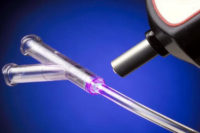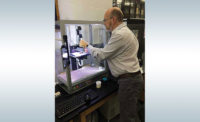Automotive engineers are intrigued by the numerous benefits of metal additive manufacturing for applications ranging from seat brackets to under-the-hood components. It’s ideal for consolidating parts and producing complex shapes.
Although additive manufacturing technology is not yet as popular as traditional stamping processes, it’s quickly evolving. Two recent initiatives in Germany are blazing a trail toward high-volume applications of production-ready parts.
BMW AG is leading a project called IDAM (Industrialization and Digitization of Additive) along with 11 partners that include the Fraunhofer Institute for Laser Technology (ILT), GKN Powder Metallurgy and the Technical University of Munich.
“By integrating metallic 3D printing into conventional production lines of the automotive industry, IDAM will enable [companies] to replace time-consuming processes, such as the production of molds, and to [customize components] at no extra cost,” says Lucas Jauer, an engineer at ILT working on the project. “In the future, it should be possible to produce at least 50,000 components per year in mass production—at the highest quality and under extreme cost pressure—with additive manufacturing.”
The IDAM project has set up two modular, automated production lines in Bonn and Munich. They cover the entire additive manufacturing process, from digital part design to physical component manufacturing all the way to post-processing.
“Individual modules can be adapted to the different production requirements thanks to the modular construction of the line and, if necessary, replaced,” explains Jauer. “In addition, process steps can be controlled and utilized flexibly.”
By taking an integrated view of automotive production into account, the project partners plan on reducing the amount of manual production steps associated with additive manufacturing from more than 50 percent to less than 5 percent. In addition, the engineers expect to slash the unit cost of 3D-printed metal parts. They are developing modular process components, such as powder handling, monitoring and automated post-processing.
Daimler AG, along with partners EOS and Premium Aerotec, is spearheading another research project called NextGenAM. The goal is to develop a next-generation assembly line that will be able to mass-produce aluminum components for automotive and aerospace applications. The companies hope to reduce current additive manufacturing costs by 50 percent by using an automated production process.
“No manual work is now required at any stage of the process, from data preparation and central powder supply through to the build process itself and heat treatment, quality assurance and separation of the components from the build platform,” says Jasmin Eichler, head of future technologies at Daimler. “A driverless transport system and robots ensure the smooth movement of parts through every stage of production.
“The entire production process runs itself, without operators, from a central, autonomous control station,” explains Eichler. “All the machines are networked. Order data is transmitted to the control station, which then prioritizes the various build requests and allocates them. During the build process, the manufacturing status can also be retrieved on a mobile device, independent of location.
“Once the full production chain has been completed, quality reports are sent back centrally to the control station,” Eichler points out. “All the data necessary for the production of a digital twin can be accessed here, [which enables] complete traceability.”
To address quality parameters and monitor part validation, Daimler engineers are currently conducting an audit based on the VDA 6.3 standard. This will enable the automaker to soon begin series-production of printed metal components.




